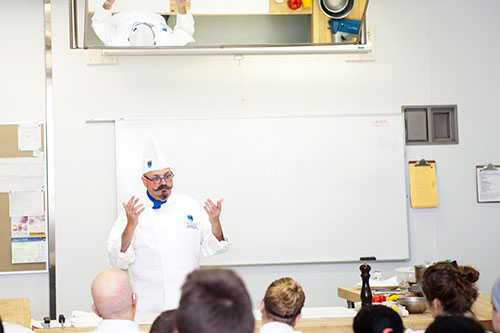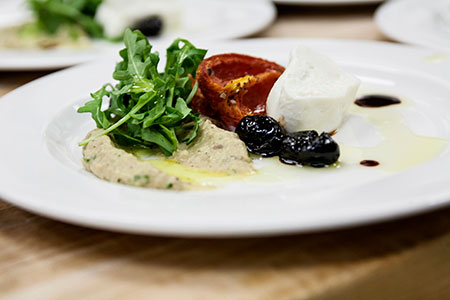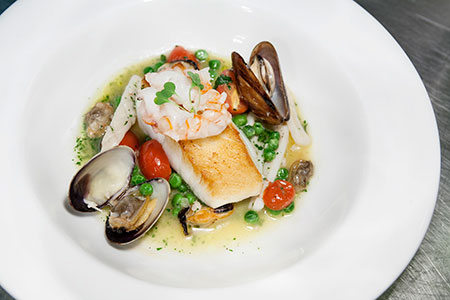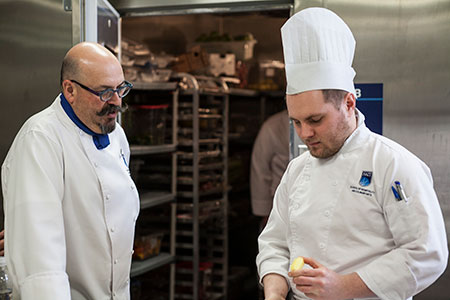One of Canada's most recognizable chefs brings authentic Italian to Culinary Arts students
Massimo Capra never decided to become a chef. Instead, he explains in a smoky, heavy accent, “I decided to become a cook.”
The subtlety of the distinction might be lost on casual diners, but it’s been essential to the career of the Italian-born, Toronto restaurateur behind Mistura and Sopra Upper Lounge.
He’d never say being a chef means having lost touch with the essence of the craft, but for him becoming a cook means establishing a practical, even sensual connection with food.
Watch Capra in action and you’ll see it.
His credo was perfectly clear during his week-long stint this March as NAIT’s 2012 Hokanson Chef in Residence. Whether he was lecturing or chopping, mixing and cooking alongside his students from the institute’s Culinary Arts program, he refused to let them believe a great chef is made by a certificate from a school.
He’s proof of that.
Capra comes from humble origins, but ones that have shaped his culinary worldview into one of the most notable in Canada. A firm believer that “It’s not good to keep secrets – especially in the kitchen,” he openly confesses to his students that, before making his name as a City TV and Food Network TV host and award-winning food writer of two cookbooks, he was no different from them.
Success, he assures (or perhaps warns) them, comes from one fundamental thing: very hard work. If Capra’s own story is any indication, while the results can be sweet, the recipe certainly isn’t easy.
 From Cremona to Canada
From Cremona to Canada
Capra grew up in a rural town in northern Italy, just outside of Cremona. It had him, like any restless teenager in any small town, longing to escape.
“If you did something wrong,” he recalls, the curlicues of his waxed moustache rising with a smile, “the next morning when your mother went to buy bread, she would find out.”
Having cooked for years for his family and even for a neighbour since he was eight or nine years old, and being unable to afford the art schools his teachers were suggesting for him, he enrolled in a state-run culinary school. He couldn’t see himself working in a factory or on a farm.
“It was a chance to do something better with my life.”
His first restaurant experience was at Trattoria dell' Amelia in Mestre, just outside Venice, one of Europe’s best restaurants of the day. The work was grueling. Capra hauled sacks of potatoes, cleaned 50-kilo bags of scallops and suffered under chefs who could have given tips on tyranny to Gordon Ramsay. Capra begrudges none of it.
“The moral of the story is I came out better.”
And ambitious. After paying dues and gaining know-how and experience in other top restaurants around Europe, Capra decided to join a cousin in Toronto in 1982, and worked in his restaurant while learning English from movies, television and newspapers.
But Canada’s Italian food scene struck him as stagnant. The ingredients he knew from home – the olive oil, the balsamic vinegar, the risotto rice, even the right kinds of tomatoes – simply weren’t available. At least not at first. Once a few importers finally opened, things changed.
“The veal parmigiana, eggplant parmigiana, the dirty lasagna were all gone,” says Capra, “and all of a sudden you were making really good things.”
All of a sudden, he was able to create dishes that would qualify him – whether or not he thought so at the time – as not just your average cook.
 The finer points of fancy
The finer points of fancy
His perception of what makes for fabulous food played as much a part in his success as being able to just get his hands on its primary ingredients.
Guiding Capra throughout his career is a bit of irony that has infused his reputation for inventiveness and consistency.
It has taken on the sheen of the type of food philosophy no self-respecting chef is without, and even branded him in the restaurant industry and on TV, where he began with hosting roles in earnest in 1997, after a local producer noticed his talent and enthusiasm in the restaurant.
It’s like this: over the years, Capra has come to recognize a disconnect in the way we see the quality of food.
He grew up on staples like farmer’s cheese, a kind of boiled salami known as cotechino, and polenta, essentially cornmeal porridge. In other words, simple, easily available food for people with limited means.
“Now it’s fancy,” he says, sounding bemused. “People used to make fun of farmers like me because we used to eat polenta instead of bread. Now, you throw in a bit of butter and cheese and everybody’s like, ‘Ooo, polenta.’”
He dislikes this kind of reaction if only for the distance it puts between consumers and the local producers he sees at the centre of the future of eating.
In fact, he’d happily reassign the term fancy to processed convenience food (for Capra, tinned wieners and beans and frozen fish sticks easily qualify). But he can’t deny that his own affection for “things that were done in the past” has been a major advantage. Discerning eaters notice.
“It’s the basis of Italian cooking: simple flavours, simple food,” says Shawn McKee (Culinary Arts ’09), an Edmonton cook who dropped by during the chef’s week on campus to get his copy of Capra’s One Pot Italian Cooking signed. “That’s what Italian cooking is and that’s what Massimo is.”
 Let’s do lunch
Let’s do lunch
“What Massimo is” encompasses many roles, but during his residency, teacher rises above the rest, particularly midway through his week at an event at Ernest’s, a fine-dining restaurant staffed by students from NAIT’s School of Hospitality and Culinary Arts.
Each year, the Hokanson chef leads students through the production of a public luncheon. Capra’s attracts some 140 diners, many of them local chefs and food writers.
The afternoon before, he and 35 students worked well into the evening on a three-course menu from his award-winning cookbook, Three Chefs – The Kitchen Men.
Made from scratch, it was exacting and at times frustrating, but encouraged by Capra’s patience and sense of humour, his students rose to the challenge – and came away with a true appreciation of their mentor.
“He’s friendly and hands-on,” says second-year Culinary Arts student Melissa Ndlovu, who spent much of the evening before the luncheon cubing eggplant. Because of him and the Hokanson program, she adds, “You leave class feeling a little more inspired.”
It shows in the meal.
It begins with a sweet and savoury salad: roasted tomato, fried eggplant croutons and a generous chunk of burrata cheese. The main is a picture of oceanic democracy, represented by sea bass, lobster, squid, mussels and scampi gathered on green pea ragout. It ends with a chestnut and chocolate panna cotta, which, almost miraculously, is rich yet delicate and light.
The overall quality gives the impression that lessons have not just been learned, but taken to heart.
Perry Michetti could not have hoped for better. Earlier in the week, the day Capra arrived, the associate dean of the School of Hospitality and Culinary Arts stood before students and told them what to expect of the Hokanson Chef in Residence. “We don’t want a TV celebrity,” he said. “We want a chef.”
By Capra’s own logic, what they really got was the same but different. “The reality to me is that we’re all cooks,” he says.
 The joy of cooking
The joy of cooking
For any student who entertains the remote possibility of graduating to food TV stardom, Capra’s statement (and the very fact that he, a star himself, is the one to utter it) could be taken to mean you can’t skip the basics.
It’s meant to be grounding, to increase their chances of success however high they climb, to perhaps even improve the industry overall.
But it’s also intended as comfort, right up to the level of celebrity chef.
To Capra, being a cook implies a relationship with food that may serve students in ways they likely don’t expect. With his own career having gravitated toward restaurateur, TV personality and acclaimed writer, the line – defined by exploring, tasting and creating – is a place he returns to whenever possible.
“I love being there. It makes me feel comfortable,” says Capra. “It makes me feel at home.”